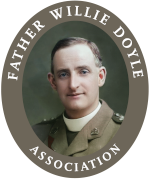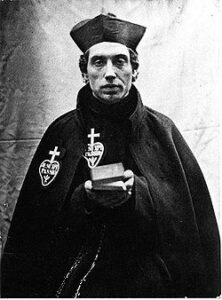Today is the feast of St Charles of Mount Argus, a Dutch Passionist priest who spent about 30 years of his life in Dublin, dying here in 1893 at the age of 71. He greatly loved by the people of Dublin, primarily because of his humility and simplicity. He was not a great preacher, but he was extremely gentle in the confessional. Like many of those who excel in the virtue of humility, he received many graces from God, including many graces within his own spiritual life as well as the grace of healing. Each day hundreds of people would flock to the monastery at Mount Argus to receive his blessing and those with means from far away would often send carriages to collect him and bring him to someone who was sick or dying. There were many reports of wonderful healings and these reports continue to this day, now that his power of intercession is even greater in Heaven.
There appears to be no mention of St Charles in the writings of Fr Doyle, but it is certain that Fr Doyle would have been aware of him. Fr Doyle was 20 when St Charles died, and his reputation for holiness was alive and well, so Fr Doyle must have been aware of St Charles and his holy life.
The feast of St Charles gives us a good excuse to consider the following important question which is relevant to Fr Doyle: Why are there so few recent Irish saints? St Charles is the only canonised saint of modern times (within the last 500 years at least) to have died in Ireland. And he wasn’t even Irish; he was Dutch! When one compares Ireland to other countries with strong Catholic heritage – Italy, Spain, Portugal, Poland, France, even parts of Germany, we perform very poorly when it comes to canonisations. Of course, it’s not a contest and the numbers themselves don’t really matter. Yet, at another level, the numbers are a kind of barometer that tell us something about the spiritual climate of a country. After all, a vibrant Catholic culture will foster holiness. This holiness will be recognised by others, who will then be motivated to promote these examples of holiness in an effective and professional manner. Other people will join in this process by praying for miracles. All of this needs institutional support from the religious orders, dioceses and parishes. Thus, a healthy, properly functioning Catholic culture will steadily produce canonised saints. The dearth of Irish saints since the Council of Trent points to something amiss about Irish Catholicism, especially when we consider the increased frequencies of beatifications and canonisations within the Church over the past 4 decades.
Let us look at the Irish situation. St Charles of course stands out, but while we have adopted him as our own, he was Dutch, and interestingly both of the miracles for his beatification and canonisation were worked in the Netherlands. St Oliver Plunkett is of course Irish through and through, but his situation was slightly different as he was a martyr which makes his canonisation a little easier. He died in London and his canonisation miracle occurred in Italy by the way. Blessed Edmund Rice also lived and died in Ireland, and his beatification miracle was worked for a man in Newry in Northern Ireland. Then of course there is Blessed Columba Marmion who was a Dubliner but who became renowned as the abbot of a Belgian monastery. He is not widely known in Ireland. His beatification miracle was worked in the United States. Then there are the 17 Irish martyrs who were beatified in 1992. Most unfortunately they are even less well known in Ireland than Columba Marmion. Most recently, John Sullivan SJ was beatified in May of 2017, the first Irish beatification in almost 2 decades.
And that’s it. Of course, it’s not for the lack of good candidates. There were dozens of other martyrs from the penal times that deserve recognition, in addition to candidates like Venerable Matt Talbot, Mary Aitkenhead, Catherine McCauley, Nano Nagle, the three Legion of Mary candidates Edel Quinn, Alfie Lambe and Frank Duff and of course Fr Doyle himself. There are of course, many other potentially worthy causes besides these that have yet to be initiated.
Some people may mistakenly believe that having local saints is an irrelevancy or of low priority. But if we truly believe in the Communion of Saints, then we want people to know about Irish saints and as a consequence to have recourse to their help in prayer. Local saints also give us a closer and more contemporary model to follow. The saints all reflect some particular aspect of God. While we should always strive to imitate Christ above all, it can be easier for some people to imitate a saint who was closer to them in time and culture and state of life. Pope Benedict recognised this reality. Speaking on this very theme at the Chrism Mass for Holy Thursday in 2012, he said:
Dear friends, it is clear that configuration to Christ is the precondition and the basis for all renewal. But perhaps at times the figure of Jesus Christ seems too lofty and too great for us to dare to measure ourselves by him. The Lord knows this. So he has provided “translations” on a scale that is more accessible and closer to us. For this same reason, Saint Paul did not hesitate to say to his communities: Be imitators of me, as I am of Christ. For his disciples, he was a “translation” of Christ’s manner of life that they could see and identify with. Ever since Paul’s time, history has furnished a constant flow of other such “translations” of Jesus’ way into historical figures.
It is true that many people have abandoned the Church in dismay in recent decades. Scandals and crimes have alienated many. Well, let us then promote models of love and selflessness who encapsulate the beauty of our Faith! Saints are model Christians who show us the Gospel lived in flesh and blood. Surely we should show people what Catholics are meant to be – we are all called to be saints, so let us show people real men and women who lived in a time and place like our own and whose lives reflect the love of Christ for humanity. Finally, the recognition of local sanctity gives a morale boost to a local Church, and we all know how badly that is needed today. In the beautiful words of Pope Benedict in his letter to the Church in Ireland in 2010 he also calls on us to remember our local saints:
As you take up the challenges of this hour, I ask you to remember “the rock from which you were hewn” (Is 51:1). Reflect upon the generous, often heroic, contributions made by past generations of Irish men and women to the Church and to humanity as a whole, and let this provide the impetus for honest self-examination and a committed programme of ecclesial and individual renewal. It is my prayer that, assisted by the intercession of her many saints and purified through penance, the Church in Ireland will overcome the present crisis and become once more a convincing witness to the truth and the goodness of Almighty God, made manifest in his Son Jesus Christ.
So, how can we all help? Firstly, pray. Pray for the canonisation of Fr Willie, and of other Irish candidates (and, if you are not Irish, pray for the candidates of your own country as well). Pray also for miracles and healings for the sick. But, very importantly, pray through the intercession of that candidate alone. Pick one candidate (whether Fr Willie, or another) and have faith in their intercession with God. While it is understandable on a human level, if you pray through the intercession of multiple saints (or saint candidates), in most situations any healing that results cannot be used to further a canonisation cause. So if you pray to Fr Willie for a healing, and then, for example, get blessed with a mitten of St Pio, light a candle to St Philomena, and then say a novena to Sr Clare Crockett, any potentially miraculous healing is very unlikely to work for a canonisation cause for Fr Willie or Sr Clare as it needs to be clearly attributed to the intercession of the canonisation candidate alone. This is no offence to St Pio, St Philomena or Sr Clare (we love them all!), but the practical reality is that in most situations, it would be impossible to discern whether Fr Willie, St Pio, St Philomena or Sr Clare’s intercession was responsible for the possible inexplicable healing. So have faith in the healing power of Christ, and the intercession of that one saint/candidate to whom you have devotion (whoever it may be), and trust in Providence. And, most importantly, if you receive any favours at all, please ensure that you report them to the Cause in question. In the case of Fr Doyle, favours can be reported here: https://williedoyle.org/report-favours/
After prayer, then action. Promote Fr Willie’s cause (or the cause of other candidates). Distribute payer cards, literature and books about them. Also please organise talks about Fr Willie, or invite us to your parish, prayer group or conference. This is an excellent way to introduce people to Fr Willie. And please don’t forget that canonisation causes cost money – a lot of it. Sometimes this comes as a surprise to people. But there is a lot printing to be done, a LOT of postage (which is increasingly expensive), expenses incurred by the tribunals and commissions, the investigation of alleged miracles (which involves travel costs and expenses for doctors and medical consultants and tribunals to investigate them), fees paid to the Dicastery in Rome for their work, and ultimately a beatification and canonisation ceremony. And that’s without paying for other promotional initiatives, such as videos, documentaries, website expenses etc. Fr Willie’s Cause is run by volunteers, and the Father Willie Doyle Association is a lay group with no support other than what we receive from donations. We trust in God’s Providence, and rely on your help.
So, let us pray and work that we may soon have more Irish saints, Fr Willie amongst them!

